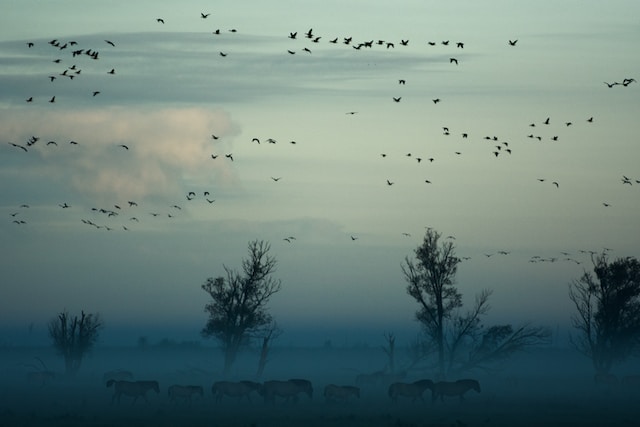
I. The Avian World in Peril
The Avian World, teeming with diversity and beauty, faces a grave threat from poisonous chemicals that jeopardize bird populations worldwide. From the smallest songbird to the mighty raptors, avian species are facing unprecedented challenges due to the impact of toxic substances. Urgent protective measures are necessary to safeguard these magnificent creatures and ensure a thriving avian ecosystem for generations to come.
II. Understanding Avian Vulnerabilities
Birds possess unique physiological and behavioral traits that make them particularly susceptible to the harmful effects of toxic chemicals. Their high metabolic rates, small size, and specialized respiratory systems increase their exposure to airborne pollutants and contaminants. Additionally, their reliance on specific feeding habits and migratory patterns may lead them to encounter contaminated food sources and habitats. Such vulnerabilities necessitate a comprehensive approach to protect avian populations from the dangers posed by poisonous chemicals.
III. Identifying Chemical Threats to Birds
Exploring the various poisonous substances that pose a significant risk to birds, such as:
Herbicides: Herbicides like “Roundup,” containing glyphosate, raise concerns for birds and wildlife due to potential health issues, including impaired reproduction and organ damage. Glyphosate has been connected to potential human health hazards like cancer and endocrine disruption. These alarming findings have led to a surge in legal actions, with people filing lawsuits against companies like Bayer, the manufacturer of Roundup, seeking accountability and compensation for alleged health damages.
Recently, the first Bayer Roundup lawsuit was won, highlighting the growing recognition of the potential risks associated with this herbicide. Calls for increased safety measures and alternatives to protect both avian populations and human well-being are growing in response to these emerging concerns and legal developments.
Pesticides: Chemical pesticides used in agriculture and pest control often have unintended consequences for bird populations. Ingesting insects or seeds treated with these pesticides can lead to acute toxicity and long-term health issues.
Lead: Lead poisoning is a significant concern for birds, especially in areas where lead ammunition and fishing tackle are prevalent. Ingesting lead-contaminated prey or scavenging carcasses can lead to severe poisoning and even death.
Mercury and other environmental contaminants: Industrial pollution and improper waste disposal release mercury and other hazardous substances into the environment. These toxins accumulate in bird tissues, impairing their reproductive systems and overall health.
IV. Safe Practices in Bird-Friendly Areas
Highlighting best practices for managing parks, gardens, and natural habitats to provide safe havens for birds away from harmful chemicals. To provide safe havens for birds away from harmful chemicals, it is essential to adopt bird-friendly practices in parks, gardens, and natural habitats. Implementing organic gardening methods, avoiding chemical pesticides, and promoting native plant species can create healthier environments for avian residents and migratory visitors alike.
V. Bird-Safe Agriculture and Pest Control
Promoting bird-friendly agricultural practices is a vital step in reducing chemical threats to bird populations. Implementing integrated pest management (IPM) techniques, such as crop rotation and the use of natural predators to control pests, can decrease the reliance on harmful pesticides. Additionally, providing suitable habitats for birds in agricultural landscapes encourages natural pest control and biodiversity.
VI. Nurturing Bird Habitats in Urban Settings
Cities and urban environments can become sanctuaries for birds by adopting safe landscaping practices and sustainable development. Creating green spaces with native plants and providing birdhouses and nesting platforms can attract birds while minimizing their exposure to toxic chemicals found in conventional urban landscaping.
VII. Community Involvement in Bird Conservation
Local communities play a pivotal role in protecting birds from chemical threats. Raising awareness about the impact of poisonous chemicals on bird populations is crucial. Engaging citizens in monitoring habitats, reporting potential chemical hazards, and participating in conservation efforts fosters a sense of collective responsibility and ownership in protecting avian species.
VIII. Advocating for Bird-Safe Policies
To effect lasting change, it is essential to advocate for stronger regulations and policies that safeguard birds from toxic chemicals on a broader scale. Collaborating with environmental organizations and government agencies can help drive meaningful legislative actions that protect avian populations and their habitats.
IX. Collaborative Efforts in Avian Protection
Successful partnerships between bird conservation organizations, scientists, and governments have shown promise in mitigating chemical threats to bird populations. Through research, public outreach, and policy development, these collaborations strengthen the collective effort to protect and preserve avian species.
X. A Hopeful Future for Avian Conservation
Despite the challenges posed by poisonous chemicals, a brighter future for avian conservation is within reach. By embracing best practices, promoting bird-friendly policies, and fostering collaborative efforts, we can safeguard bird populations and ensure a thriving avian world for generations to come. Together, we hold the key to preserving the beauty and wonder of our feathered friends and the ecosystems they inhabit.